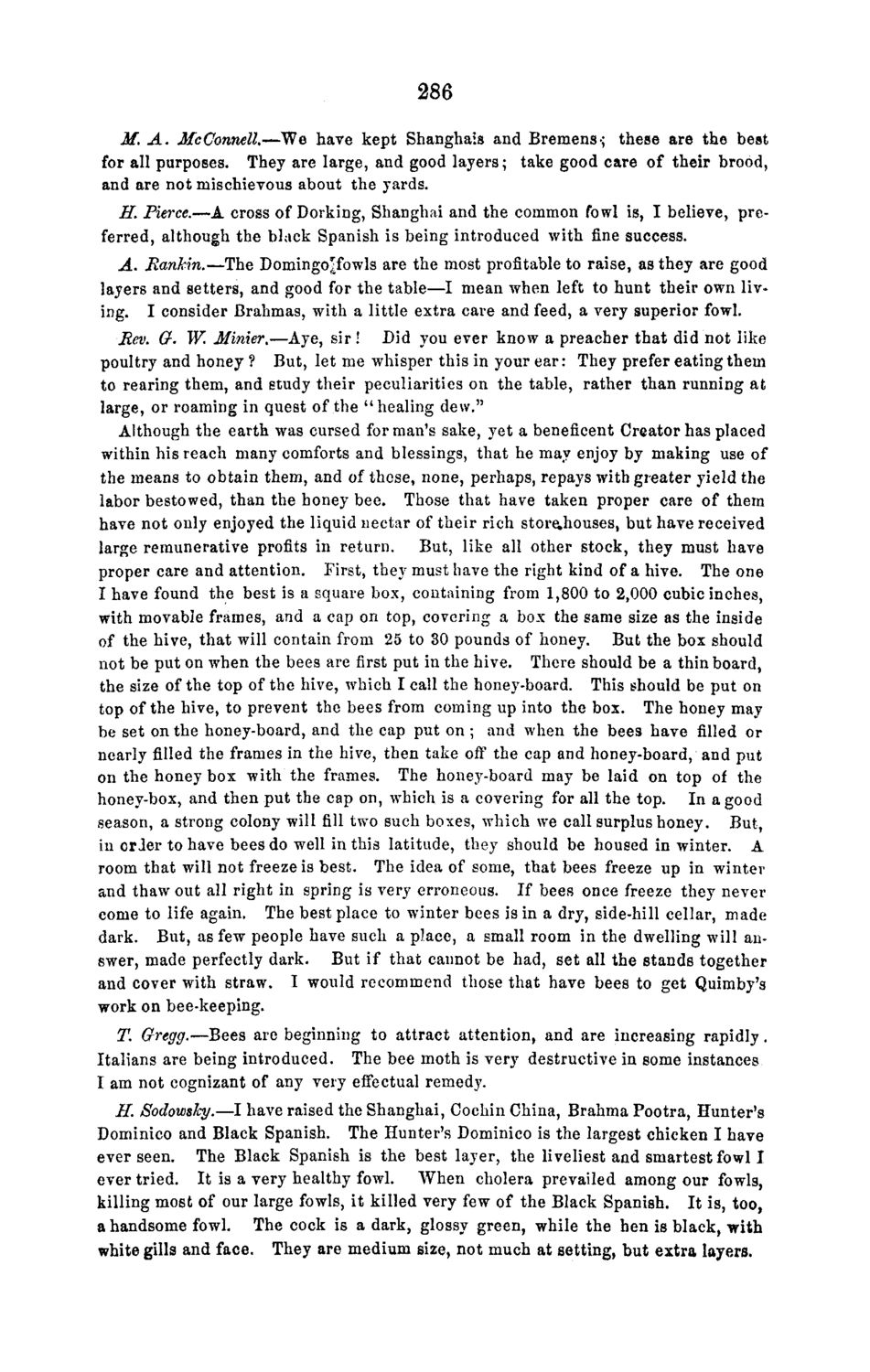| |
| |
Caption: Board of Trustees Minutes - 1868
This is a reduced-resolution page image for fast online browsing.

EXTRACTED TEXT FROM PAGE:
286 M. A. McConnell.—We have kept Shanghais and Bremens-; these are the best for all purposes. They are large, and good layers; take good care of their brood, and are not mischievous about the yards. H. Pierce.—A cross of Dorking, Shanghai and the common fowl is, I believe, preferred, although the black Spanish is being introduced with fine success. A. Rankin.—The Domingopbwls are the most profitable to raise, as they are good layers and setters, and good for the table—I mean when left to hunt their own living. I consider Brahmas, with a little extra care and feed, a very superior fowl. Rev. G. W. Minier.—Aye, sir ! Did you ever know a preacher that did not like poultry and honey ? But, let me whisper this in your ear: They prefer eating them to rearing them, and study their peculiarities on the table, rather than running at large, or roaming in quest of the "healing dew." Although the earth was cursed for man's sake, yet a beneficent Creator has placed within his reach many comforts and blessings, that he may enjoy by making use of the means to obtain them, and of these, none, perhaps, repays with greater yield the labor bestowed, than the honey bee. Those that have taken proper care of them have not only enjoyed the liquid nectar of their rich storehouses, but have received large remunerative profits in return. But, like all other stock, they must have proper care and attention. First, they must have the right kind of a hive. The one I have found the best is a square box, containing from 1,800 to 2,000 cubic inches, with movable frames, and a cap on top, covering a box the same size as the inside of the hive, that will contain from 25 to 30 pounds of honey. But the box should not be put on when the bees are first put in the hive. There should be a thin board, the size of the top of the hive, which I call the honey-board. This should be put on top of the hive, to prevent the bees from coming up into the box. The honey may be set on the honey-board, and the cap put on ; and when the bees have filled or nearly filled the frames in the hive, then take off the cap and honey-board, and put on the honey box with the frames. The honey-board may be laid on top of the honey-box, and then put the cap on, which is a covering for all the top. In a good season, a strong colony will fill two such boxes, which we call surplus honey. But, in crier to have bees do well in this latitude, they should be housed in winter. A room that will not freeze is best. The idea of some, that bees freeze up in winter and thaw out all right in spring is very erroneous. If bees once freeze they never come to life again. The best place to winter bees is in a dry, side-hill cellar, made dark. But, as few people have such a place, a small room in the dwelling will answer, made perfectly dark. But if that cannot be had, set all the stands together and cover with straw. I would recommend those that have bees to get Quimby's work on bee-keeping. T. Gregg.—Bees are beginning to attract attention, and are increasing rapidly, Italians are being introduced. The bee moth is very destructive in some instances I am not cognizant of any very effectual remedy. H. Sodowshy.—I have raised the Shanghai, Cochin China, Brahma Pootra, Hunter's Dominico and Black Spanish. The Hunter's Dominico is the largest chicken I have ever seen. The Black Spanish is the best layer, the liveliest and smartest fowl I ever tried. It is a very healthy fowl. When cholera prevailed among our fowls, killing most of our large fowls, it killed very few of the Black Spanish. It is, too, a handsome fowl. The cock is a dark, glossy green, while the hen is black, with white gills and face. They are medium size, not much at setting, but extra layers.
| |